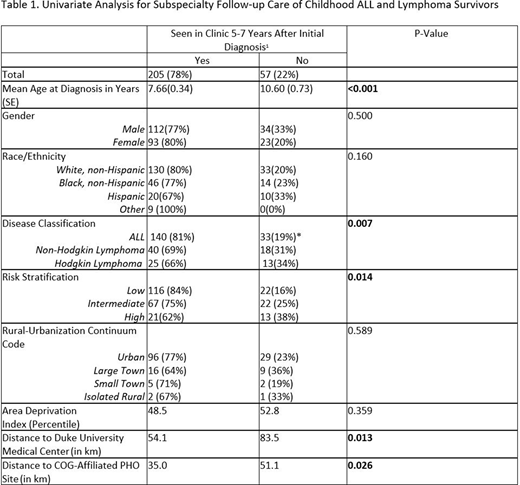Background and aims:
Marked improvements in pediatric oncology care for children with acute lymphoblastic leukemia (ALL) and leukemia emphasize the importance of appropriate follow-up care for childhood cancer survivors (CCS) to monitor for late effects. The electronic health record (EHR) sparks unique approaches to construct, maintain, and leverage CCS cohorts to improve care. The primary purpose of this study is to utilize a novel approach to integrate EHR and cancer registry data to construct a CCS cohort for ALL and lymphoma survivors. Data mining in the EHR facilitates stratification of patients into risk cohorts and identification of high risk patients with inadequate subspecialty survivorship care
Methods
Cancer registry data from January 1, 1994 to November 30, 2012 provided a base cohort from which pediatric oncology clinic visits were extracted from the EHR. Explanatory variables included gender, race/ethnicity, risk stratification, distance to the medical center, rural-urban commuting area code, and area deprivation index as a measure of socioeconomic status. Primary outcomes included date of last clinic visit to determine appropriate follow-up, defined as being seen in a subspecialty clinic between five and seven years after initial diagnosis. Patients who died or relapsed during the seven year follow-up period were excluded from the analysis.
Results
Between January 1, 1994 and November 30, 2012, there were 262 pediatric oncology patients evaluated at our institution and reported in the cancer registry who were alive and without evidence of recurrence seven years after initial diagnosis. Of these patients, 22% of patients (n=57) were considered to have inadequate follow-up care. In univariate analysis, younger age (p<0.001), primary diagnosis of ALL compared to lymphoma (p=0.007), low risk strata (p=0.014) and closer proximity to primary treatment center or Children's Oncology Group-affiliate site (p=0.013 and 0.026, respectively) were associated with a higher likelihood of follow-up care. Multivariable logistic regression modeling is currently ongoing.
Conclusions
Integration of EHR and cancer registry data represents a feasible and novel approach to construct a cohort of childhood ALL and lymphoma survivors, risk stratify patients based on treatment exposures, and assess adequate subspecialty survivorship care. Future applications include refinement of treatment exposures through the EHR, adherence to guideline recommendations, and other late effects outcomes.
No relevant conflicts of interest to declare.
Author notes
Asterisk with author names denotes non-ASH members.


This feature is available to Subscribers Only
Sign In or Create an Account Close Modal